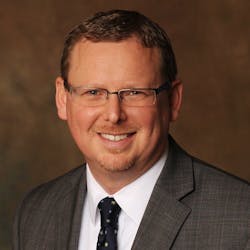2022 was a year of change. Funding changed dramatically as dollars from the infrastructure bill began to reach state revolving funds for disbursement. There was a shift in regulations, particularly in relation to per- and polyfluoroalkyl substances (PFAS), and Wastewater Digest also noted changes in workforce as the older professionals of the industry retire and the younger ones move up the ranks.
By all accounts, 2023 looks to maintain this status of change as professionals await further regulatory changes related to PFAS; clear guidance on Build America, Buy America; and yet another year of infrastructure funding from the Infrastructure Investment and Jobs Act — referred to as the Bipartisan Infrastructure Law by EPA. These challenges, however, also present opportunities.
What follows are the insights and outlooks of experts from Water Environment Federation, the National Association of Clean Water Agencies, WateReuse Association and US Water Alliance for the coming year.
Making the Most of the Increased Funding
The last couple years have created a path for substantial transformation across the water sector, and 2023 will be a critical year to execute on opportunities. With the influx of federal funds through the American Rescue Plan (ARP), the Bipartisan Infrastructure Law (BIL), and the Inflation Reduction Act, wastewater agencies have funding resources to tackle both old and new challenges, such as aging infrastructure, nutrient management, climate resilience, emerging contaminants and water equity.
While the increased funding is only a drop in the bucket relative to the overall need, it is a significant boost and presents an opportunity for utilities to embrace new technologies and management approaches that could set the course for the next 50 years of the Clean Water Act.
Not entirely by accident, this vision for the future of water aligns with WEF’s new Strategic Plan, which has a vision of “Life Free of Water Challenges” and is focused on workforce development, support for water professionals, and advancement of a circular water economy. Tackling the challenges the water sector faces will require a talented and diverse workforce, unconventional collaboration, and expanding recovery of energy, nutrients and water.
So what stands between where we are today and the utility of the future?
There is a heavy burden on utilities to identify the right solutions and convince regulators and funders that a potentially novel approach is the appropriate path. The ARP and BIL use the Clean Water State Revolving Fund or its eligible projects criteria to distribute much of the funding, which means that Although innovative solutions are allowed, historically, funds go primarily to tried-and-true approaches.
While those might be still the best solution for certain challenges, if the water sector is going to embrace a future that includes a circular water economy or solves intractable problems like water equity and emerging contaminants, now is the time for utilities to convince state permit writers and funding agencies that an unconventional solution is the right solution.
Aggressively seeking the funds is also important. The roughly $50 billion for drinking water and wastewater BIL funding will be available until federal fiscal year 2026. For there to be potentially additional future increases to federal funding for water infrastructure, it is important that the funding through the BIL be fully allocated to projects in communities nationwide by the time Congress considers drafting a BIL 2.0.
The timely distribution of federal funding towards projects and using those funds creatively to solve local water infrastructure investment will be a water sector-wide priority for 2023 and the next couple of years. Congress, the U.S. Environmental Protection Agency, state infrastructure funding agencies, and state regulators need to see the water sector tackling big challenges with innovative solutions, and that, in so doing, the sector expects continued support from federal and state government.
Goodnight 2022, Hello to a Busy 2023 for Clean Water
As the year end nears, the clean water community can reflect on a truly busy and unique regulatory year. From the U.S. Environmental Protection Agency’s (EPA) efforts to revise a nearly three-decade old affordability framework, a third rewrite of the Waters of the United States (WOTUS) regulations, and a novel proposed hazardous substance designation for two prominent per- and polyfluoroalkyl substances (PFAS) under the Comprehensive Environmental Response, Compensation and Liability Act (CERCLA) — the clean water sector was on its regulatory toes in 2022.
The year ahead will be even more demanding as the 2022 proposed efforts churn through the regulatory promulgation machine. It is expected that many of the above regulatory policies will be finalized in 2023. In addition, the sector will undoubtedly witness increased regulatory activity as the time frame to achieve certain policy outcomes dwindles with the 2024 Presidential election coming closer into view.
This Administration’s continued acceleration of action on PFAS is not likely to wane. It is imperative that the water sector pay close attention to PFAS issues and remain engaged on this complex and ever-growing topic. PFAS will have profound impacts on water systems and, further, paves a regulatory path forward for how EPA and other federal agencies may address other emerging contaminants (e.g., microplastics) to come. NACWA and the public clean water community plan to keep up the advocacy and even turn up the heat, including on Congress for a narrowly tailored PFAS exemption from CERCLA.
NACWA expects the following movement on PFAS next year that will undoubtedly impact the clean water sector:
- A final rule designating PFOA and PFOS as hazardous substances under CERCLA;
- Proposed rule-making to establish national drinking water regulations for PFOA and PFOS;
- Effluent limitation guidelines for certain industrial categories discharging PFAS;
- Finalization of the multi-laboratory validation study for Method 1633 and promulgation of this analytical method under Clean Water Act Part 136;
- Final recommended ambient water quality criteria for PFOA and PFOS and possible proposal of human health water quality criteria for PFAS; and
- The anticipated review from the Scientific Advisory Board on a biosolids pollutant screening tool and problem formulation.
Ensuring that utilities have access to the funding and financing they need will clearly remain a core priority as these regulations come down the pike. Costs are rising both for traditional clean water investment needs like maintaining aging infrastructure and meeting compliance obligations, along with newer challenges increasingly coming into focus in 2023, such as addressing emerging contaminants and ensuring system resilience in the face of climate change and cyber risks.
While the water sector witnessed historic funding through the Infrastructure Investment and Jobs Act (also referred to as the Bipartisan Infrastructure Law), it is critical to ensure these Congressional dollars are flowing as intended to communities. Continued robust funding for key water programs such as the Clean Water State Revolving Fund and the Water Infrastructure Finance and Innovation Act program is essential to ensure increased federal investment is not a one-time aberration but continues to grow.
While this trip around the sun has been busy, the regulatory and legislative outlook for 2023 appears to be just as busy!
New Horizons for Water Reuse in 2023
Water reuse technologies have been championed by a stalwart community of experts for decades. In 2022, we succeeded in advancing the vision that water reuse as an indispensable solution to interlocking climate, infrastructure, water quality and water supply challenges.
U.S. Environmental Protection Agency Administrator Michael Regan gave voice to this expanded vision in his remarks at the COP27 climate conference in Egypt last November.
“Water reuse is a key climate adaptation tool that can be leveraged to combat flooding and drought,” Regan said. “EPA not only supports the adoption of these innovative solutions but is helping to make them accessible by developing tools and partnerships with the National Water Reuse Action Plan.”
In 2023, WateReuse Association is advancing opportunities for water reuse in emerging regions such as the East Coast and Midwest. We continue to advocate for Congress to fund the Pilot Program for Alternative Water Source Grants, the first federal water reuse grant program available in all 50 states, D.C. and Puerto Rico. This program would come as communities across the U.S. are turning to water reuse to solve issues beyond drought such as combined sewer overflows, poor water quality, and stronger discharge regulations.
In recognition of the rapid emergence of water reuse in the southeast, WateReuse Association is holding its annual WateReuse Symposium March 5 to 8 in Atlanta, Georgia with opportunities to hear from local practitioners and tour regional facilities.
Another trend to look for in 2023 is the fast growth of industrial water reuse as major companies plan for climate resilience and set ambitious environmental goals. Late last year, Amazon Web Services set the bar by committing to go “water positive” by 2030, relying significantly on water reuse. To keep the ball rolling, WateReuse Association partnered with the U.S. Chamber of Commerce, Veolia, and the UPenn Business Venter to launch an Industrial Water Reuse Champion Award. The inaugural award will be announced at the 2023 WateReuse Symposium. The water reuse landscape continues to be reshaped by funding in 2021’s Bipartisan Infrastructure Law. Major water reuse projects are moving forward nationwide with federal support, such as El Paso’s Advanced Water Purification Facility and Monterey One Water’s Pure Water Monterey groundwater replenishment project. WateReuse Association collaborates with stakeholders to use these funds for the next generation of water reuse projects.
Meanwhile, the WateReuse state and regional sections continue to lead on collaborative efforts to establish state regulations which will provide frameworks for potable reuse. This past November, the Colorado Water Quality Control Commission provided final approval of a new Direct Potable Reuse rule, a process in which WateReuse Colorado members were integrally involved. 2023 promises advances in California, where Direct Potable Reuse criteria are expected by the end of the year. WateReuse sections are also working to advance regulations in Arizona, Florida, and beyond. From coast to coast, WateReuse Association is excited to see what another year of collaboration, innovation, and public education will achieve for water reuse and the communities that it benefits.
Realizing an Equitable, One Water Future in Underserved and Small Communities
By Emily Simonson, Director of Strategic Initiatives, US Water Alliance & Paula Conolly Director of Local Engagement, US Water Alliance
Under-served and environmental justice communities exist in rural and urban communities alike, but water and wastewater utilities in small communities face particular and acute challenges compared to their larger counterparts. And they face those disproportionate challenges for systemic reasons for which there are no silver bullets.
At the US Water Alliance, we are on a mission to build a sustainable One Water future for all. We are at an inflection point in that journey where we need to do more to address the disparities that exists between small and large communities’ water services.
Consider a community we recently encountered on a technical assistance trip with our partners at the Environmental Finance Center at the University of North Carolina. Lynchburg, South Carolina’s, 430 people — 90.2% Black and 31.6% total living below the poverty rate — have a water system that experiences frequent main breaks and pressure loss and produces rusty brown water when it comes out of the tap. Because Lynchburg’s system only has one operator, even the mayor has to occasionally drive around and read meters — an important task since the town’s only sources of revenue are water rates and property taxes. Beyond the water situation, 34% of Lynchburg’s housing stock stands vacant, and low wages and lack of opportunity drive many young people to live elsewhere.
At the same time, the people of Lynchburg are incredibly strong, spirited and resourceful. They have a vision of a brighter day for their community , where businesses and families feel confident in the water system and where everyone’s health benefits from the investments they have found a way to make in their water system. Their leaders are determined civil servants and willing partners in the search for solutions.
Congress and the Biden Administration created a promising opportunity for communities like Lynchburg when the Infrastructure Investment and Jobs Act became law in 2021. The Infrastructure Investment & Jobs Act grew the funding available for water and wastewater infrastructure and also the funding available to provide communities with technical assistance to be able to access those dollars.
However, business as usual technical assistance where a successful SRF application is the measure of success is not good enough for Lynchburg and the many communities out there facing similar circumstances and harboring similar dreams. Funding alone will not guarantee that projects will be affordable, advisable, or do the greatest possible good for that community. Focusing only on what infrastructure to build with no regard for the broader community demographic, economic trends and potential opportunities is also a missed opportunity with potential implications for how well the infrastructure will be operated and maintained over time or whether local residents will be able to participate in the construction or water workforce.
That is why the Alliance is excited to develop and test a more holistic approach to technical assistance as we create our own National Environmental Finance Center for Equitable Infrastructure. Together with our partners, we will strive to ensure that water infrastructure investments address entrenched inequities, promote sustainability and economic opportunity, and mitigate unintended consequences. Guided by a principled approach, we commit to considering ways to stack investments in ways that promote multiple benefits and consider thoughtfully what residents and businesses can afford over time. We are motivated and inspired to support residents and local leaders in Lynchburg and other small, underserved, and motivated communities across the country to realize an equitable One Water future.
About the Author
Bob Crossen
Bob Crossen is the editorial director for the Endeavor Business Media Water Group, which publishes WaterWorld, Wastewater Digest and Stormwater Solutions. Crossen graduated from Illinois State University in Dec. 2011 with a Bachelor of Arts in German and a Bachelor of Arts in Journalism. He worked for Campbell Publications, a weekly newspaper company in rural Illinois outside St. Louis for four years as a reporter and regional editor.






